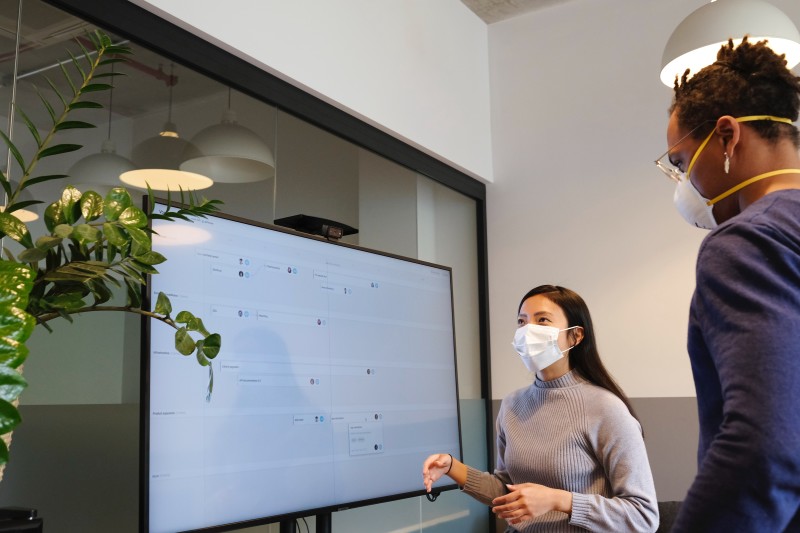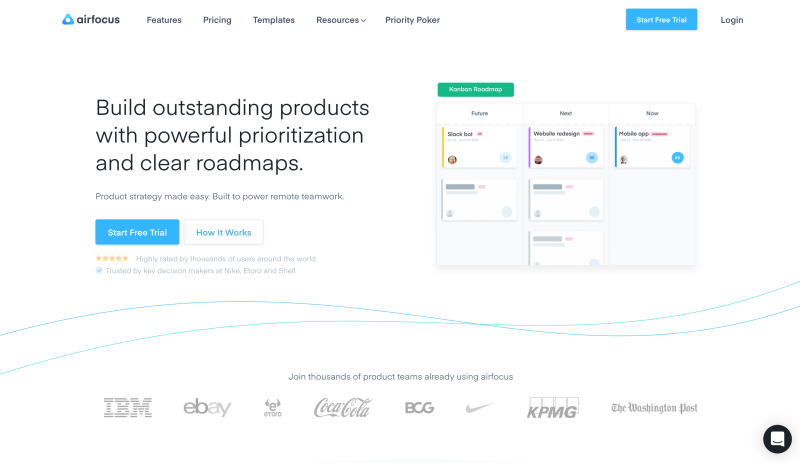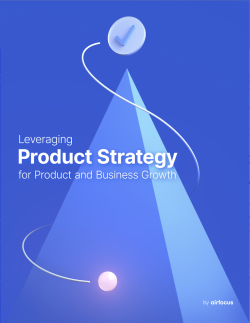
Nobody ever said building a digital product was easy.
In fact, if you’re a product manager, you’ll know that sometimes the exact opposite can be true.
Throw in paradigm-shifting global events changing the way we work forever and boy oh boy, do you have a recipe for some headaches.
But it’s not all bad.
After all, we’re an adaptable bunch, us humans.
And, just like the many other crises we’ve collectively faced over the years, we’re all finding new ways to work and collaborate, and the world moves towards the (say it with us) “New Normal.”
No matter what you think of that phrase, there’s no question that the way we work has changed radically — and we all need to adapt now.
Luckily, there’s already a lot of great advice out there to help anyone — including product teams — do their best work and stay resilient.

So, let’s go ahead and thicken that skin.
The 5 pillars to lead your team through the COVID crisis
It sounds cliche, but the global pandemic really did take us all by surprise.
In fact, even those familiar with global crises like these might not have predicted the scale of impact COVID-19’s had on businesses around the world.
So how do you, as a leader, help your team through this?
One answer is empathy. We all react differently in the face of adversity, so each person must be treated differently when doing their work. Whether you’re leading a whole business, a product team, or even a small silo of engineers — this stuff matters.

To help shed some light on potential paths through the crisis, management consultant experts McKinsey & Company have created 5 pillars of guidance:
Resolve. This pillar is about taking immediate action to address not just the concerns of your team but also the needs of your customer (which may well have changed).
Resilience. Such seismic shifts in the global economy can result in financial strife, so short-term management and long-term planning are essential.
Return. Simply put: how is your business (and your product) going to return to its optimal pre-COVID state?
Reimagination. “Adapt or die.” That’s at the core of this pillar. You need to be prepared for significant restructuring to weather this storm.
Reform. This pillar is about looking outwardly at the world. Has regulation changed? Is more help available for your business now?
Now that you’re familiar with the high-level basics of these pillars, it’s time to drill down into the detail.
Let’s look at each of them in-depth and explore how they impact product teams, the work they do, and the products they create.
1. Resolve
The first of these pillars is arguably most important because it sets the stage for everything else. And what it really boils down to is this: fight or flight.
As the impact of COVID makes its way through all industries, all verticals, and all businesses, leadership must be able to tackle the problem head-on. This isn’t something that’s going to come and go — it’s a huge, life-altering event that will result in a pre-COVID and post-COVID world.
In short? You, as a business leader, need to resolve to tackle issues right away. Be decisive.

So how does this apply specifically to a product team? Here are just a couple of ways that product teams might be impacted:
Being open to a hard pivot. Both you and your entire product team understand that you’ve been building a product to solve a particular need. You might even have been working on it for years. But is it still necessary in a post-COVID world? Don’t fall for the sunk cost fallacy — if your product needs a pivot, don’t bury your head in the sand… make it happen immediately.
Understand that data may be scarce. With customer behavior changing, your ability to test out ideas in a data-driven way might be limited. What’s more, we are (quite honestly) living through never-seen-before times — there’s no pre-written manual based on the previous experience of business masterminds. Instead, you’ll need to fall back on natural intuition — and you might be surprised at how much of that your team has on hand.
Honesty is the best policy. Whether you meet regularly for backlog refinement sessions or you’re in constant contact via Slack or other channels, communication is still key. As the leader of a product team, you should resolve to be honest with all team members about which decisions you’re making and why.
2. Resilience
Let’s be real for a moment: business always comes down to the bottom line.

There’s a natural inclination to focus product teams less on driving revenue and more on driving the customer experience — and this is a good thing. But in a post-COVID world, or even as the pandemic progresses? Things might need to change, even just for a while.
The problem here is short-term financial management.
Before the crisis began, your entire roadmap was probably geared towards particular milestones. Whether the product is already live, and you’re pushing new features and updates, or it was due to be launched soon, each of these milestones would have had a financial value attached to it.
But what happens if your user base drops off? What happens if a particular feature will no longer be valuable (such as anything related to live events)? It’s here that the waters can get a little bit murky because suddenly, all of those tasks on the roadmap lose a lot of their value, and it might be time to rebuild it — at least in part.
Once again, we find ourselves on the topic of pivoting. We�’ve seen plenty of companies already embracing the pivot during the pandemic, with breweries producing hand sanitizer and clothes manufacturers creating PPE.
The questions you’ll need to ask as someone responsible for a product team are:
Does our existing roadmap still reflect the needs of our customers in a post-COVID world?
Are there any ‘easy wins’ we could add to the roadmap? Will these generate income quickly to fill potential revenue gaps?
How much of our existing roadmap needs to be replaced or reworked?
Do we need to hard pivot and rethink the entire product?
We’re not saying any of these questions are easy to answer — because they’re just not — but you must ask them.
No matter how financially resilient you think you are, this crisis will bite. And being prepared is the best way to get through to the other side.
3. Return
Okay, fair warning — we’re going to use that phrase. You know, the one some people aren’t too keen on.
Yep, you guessed it… The New Normal.

This is something that many businesses are struggling with, and for good reason. After all, your natural muscle memory will be pushing the business to operate just as it has for the last however many years.
The only problem? The rules have entirely changed.
Let’s take an example of a rug manufacturer. It would be easy enough to start the factory back up again, have all the staff come in and be socially distanced, and get the great machine churning again.
But what about the supply chain?
A business like this relies upon several suppliers, probably from all over the world, to deliver the raw materials necessary to create the final product. So what happens if one of these suppliers is shut down or disrupted? Potentially… chaos.
A business is only as strong as the weakest link in the chain. Likewise, its ability to return to pre-COVID productivity depends on this chain being up and running smoothly.
In the context of product development, you might assume that such concerns aren’t applicable. After all, if the work is created purely in the digital realm, why can’t things just go back to normal asap?
Sadly, it’s not that simple.
After all, your digital product relies on a steady flow of users to keep it alive. Disrupt this flow and, as we discussed above, revenue is impacted and your ability to develop new features grinds to a halt.
So, how do you solve this?
It’s not easy, but here are a few starting points:
Have a backup plan in place. Even if you’re able to resume your product development where it left off, the ripple effects of COVID may impact your user base further down the line. That being the case, it’s essential to have a contingency plan if your flow of new users is disrupted.
Lean on the agile model. There’s a reason that agile development is called, well, agile. The ability to quickly make changes — or change direction entirely — is built right into this development process. So, if the global situation changes to the extent that features in active development are no longer needed, you can update the roadmap and reprioritize. (The airfocus team can help here, too).
4. Reimagination
“Reimagination” is a big word. It can mean lots of different things.
Some of those things, we’ve already covered — taking a hard pivot, for example — but reimagination is also about your team.
New rule book
Navigating COVID has required an entirely new rule book. Not just to redefine the work we’re doing, but the way we’re doing it, too. With so many of us working from home and relying on digital tools to get our jobs done, it’s vital that businesses be able to reimagine the way teams work with one another.
This actually ties back into something else we touched on earlier: the idea of empathy is at the heart of building a business (and a team) in a post-COVID world.
Everyone has faced different challenges during the pandemic. For some of us, working from home has been a blessing; for others, it’s been a constant challenge. As a team leader, understanding that you can’t treat everyone the same is absolutely critical to carving a path forward with a team that genuinely want to be on the journey with you.
So how do you reimagine the various areas of your business (or just your product team) without causing too much distress or alienation? Again, it’s no mean feat, but here are some pointers to get you started:
Offer flexibility where necessary. Some of your product team might want to work from home for their own safety, others might be really eager to come into the office a couple of days a week. Being open to these ideas will be an important part of reimagining your business — and its productivity — in the coming months (or years).
Ask your team to be open to responsibility changes. Whether team changes are mandated by financial performance, or simply because circumstances demand it, it’s important that your product team be open to trying new things. This might be working on areas of the product they’ve never touched before, or even learning new skills like coding. We’re all in this together, after all.
Make the most of available technologies (or take the chance to retool). You’re a digital team already, so you’re already a step ahead. But reimagining your business means making the best use of digital tools. Whether this is communicating with tools like Slack, or simply rebuilding your backlog with a tool like our very own airfocus, they’re all very useful in a post-COVID digital world.
5. Reform
Last but not least, let’s consider the final pillar: reform.
While there are some similarities with reimagination, the focus of this particular pillar is really in the long-term.
Naturally, we’re all more focused on the short-term right now. It’s no longer about ‘how can we delight customers in 2021 and 2022?’, but rather, ‘how can we be sure to make it to year-end 2020?’.
And while that’s a pretty bleak state of affairs, take some solace in the fact that most other teams are thinking the same thing. In fact, this last part is really important, because guess what — none of this was your fault.
If your business is struggling to develop a new product due to staff shortages, lack of finances, or even just a drop-off in usage, it’s not because of anything you did specifically. These conversations are happening in offices (or via Zoom!) in teams all over the world. There’s a struggle in every industry. A strange solace, perhaps, but a solace nonetheless.
And global governments are paying attention.
As you look to reform your business and restart your product management team in a more resilient way, it’s vital that you keep an ear to the ground on support initiatives. Programs like the Paycheck Protection Program (PPP) in the USA or the Coronavirus Job Retention Scheme in the UK are designed to give businesses a bit of financial ballast and keep them afloat until things return to some normality.
And then there are the potential positives that may come out of this global catastrophe. Hard to see right now, perhaps, but the crisis has forced a global experiment into work-from-home — one that could easily result in a better work/life balance for millions. Not only that, but the pandemic has forced leadership and staff alike to communicate in new ways, reach out to new customers, and explore areas of business that they may never have touched 12 months ago.
So while nobody would ever have chosen to have the catalyst for this change be a global pandemic, it’s sometimes uplifting to remember that your business could well come out of this stronger, more resilient, and more unified than before it began.
Not only that, but you may also find your product management team will become more effective. You’ve all been forced to work in a more agile way, and lean on digital tools to drive new efficiencies — even when under immense pressure.
And, as you may know: diamonds are made under pressure.
Build a stronger product team than ever before — powered by airfocus
Let’s face it: the world of work has changed.
To nurture a successful product team in a post-COVID reality, you need all of the strategies we’ve covered here — and probably some we don’t even know about yet, too.
If you’d like to set the stage for a product team that can do their work in a way that makes them feel safe, supported, and comfortable, airfocus can help.

Try out our prioritization and roadmapping platform today with a free trial and discover how it could help bring your product team together, even when they’re apart.

Malte Scholz

Read also



Create effective product strategy

Experience the new way of doing product management




